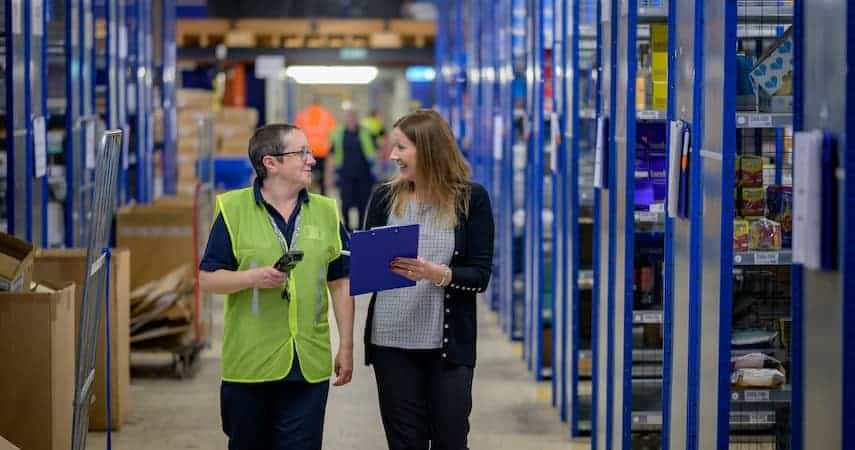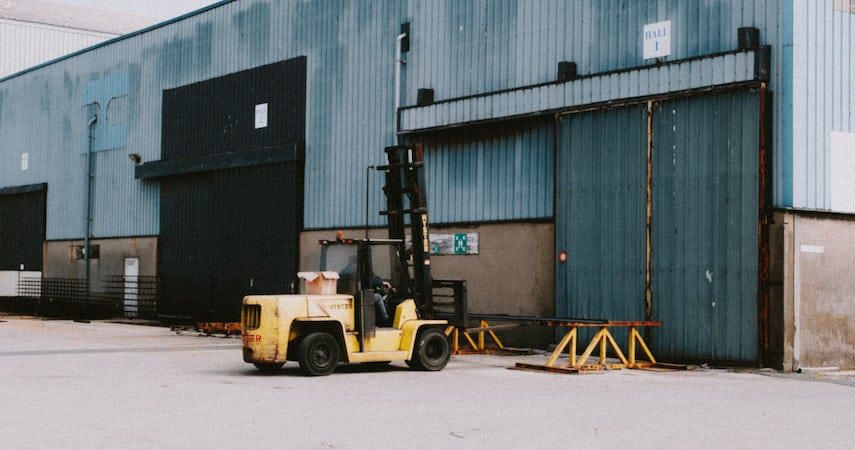
Warehouse management is the vital link between receiving goods from suppliers and delivering orders to your customers. It's how a product business controls its portion of the supply chain. In warehouse management, warehouse logistics ensures these processes are optimised to cut costs and boost efficiency.
This article untangles the jargon of warehouse logistics, explores its benefits and challenges, and breaks down the best practices that can help improve supply chain management.
What is warehouse logistics?
Warehouse logistics refers to the management of all the processes involved in controlling inventory in your warehouses and storage units. It’s an important part of supply chain management that ensures the smooth and cost-effective transition of products through warehousing to their final destination.
The role of warehouse management in logistics
In logistics, the role of warehouse management is to ensure the optimisation of the warehousing of products and raw materials. This means creating efficient systems and workflows, including the handling, storage, and shipping of goods into the warehouse and out to the customer.
Warehouse management is important in logistics and operations because it ensures customers receive the goods they ordered on time. Any issues that arise in warehouse logistics can impact customers and, in turn, lead to brand damage and reputational harm.

The warehouse logistics process
The warehouse logistics process can be broken down into six steps:
- Receiving
- Inventory management
- Warehouse management
- Order picking
- Packing
- Shipping
Let’s explore these steps in more detail.
1. Receive goods, products, or raw materials from suppliers
When items are delivered from suppliers, the warehouse logistics team needs to document, track, and authorise the receipt of the products.
The receiving process involves checking:
- The quantity of goods matches the original purchase order
- The goods have arrived undamaged and without defects
- The goods arrive within the timeframe estimated by the supplier
- The price of the goods matches the originally agreed-upon price
The receiving team will then ensure all internal documentation is updated to guarantee ongoing accuracy when tracking the items.
2. Inventory management
Once inventory has been received in the warehouse, it needs to be strategically stored and managed to suit the business’s needs. This process is called inventory management.
There are many inventory management methods designed to optimise the flow of goods around the warehouse. You can also increase the efficiency with which inventory is managed using warehousing equipment such as pallet racks, automated storage and retrieval systems, and warehouse inventory management software.
The key to effective storage of items is to ensure access to higher turnover items is easy. Items that move more slowly can be stored in less accessible places (such as on higher shelves or further back in the warehouse).
3. Warehouse layout optimisation
Ensuring products are stacked in effective ways is one part of the inventory management process; another element is the layout and design of the warehouse. Good warehouse layout and design will ensure products flow in and out without having to cover unnecessary ground.
We spoke with Jack Underwood, CEO and co-founder of Circuit, about warehouse layout optimisation. He had this to say:
“Set up your warehouse to minimize errors and increase productivity. Don’t mix multiple SKUs in the same spot, place popular products in optimal, accessible locations, and incentivize pickers with bonuses for speed and accuracy.”
A common way to design a warehouse is by creating a U-shape, where products are received at one end of the U, stored at the bottom of the U, and shipped for delivery at the other end.
4. Picking
The warehouse logistics team is responsible for picking items around the warehouse to move them to the next stage in the supply chain.
In the case of raw materials, this means shifting them to the production line. For finished goods, order picking can mean collecting each item from a customer's order and moving them to the packing area.
Different strategies can be utilised to optimise the order-picking process. For example, batch picking enables multiple requests to be fulfilled at any one time. Zone picking, on the other hand, is used when products are placed in a particular area of the warehouse for easier identification.
5. Packing
Once a customer order has been picked, it will need to be prepared for transit to the customer’s delivery address. This is known as the packing process.
Packing can have a major impact on customer satisfaction. Effective packing ensures goods arrive on time, undamaged, to the correct destination.
If a product is fragile – for example, a clay cup – the job of the packing team is to ensure it does not break before it gets to the customer.
The packing process can involve:
- Protecting goods with bubble wrap, foam peanuts, or other packing materials
- Packing products into the vessel (envelope, parcel, box) that it will be shipped in
- Adding warning labels to the outside of the package
- Updating internal documentation and records
- Alerting the shipping team and the customer that the order is ready to be shipped
Packing is also an essential warehouse logistics process because it is the final opportunity to check the order's accuracy before it is shipped.
6. Shipping
The final step in warehouse logistics is ensuring effective delivery of the goods to the customer or the next storage facility.
This step involves fulfilling orders from customers in a way that is efficient and cost-effective. A shipping label must be attached to the package and transportation organised before it can go out the door.
It is also the responsibility of the warehouse delivery team to monitor a shipment while it’s in transit, resolve any delivery issues, and make a record of any shipments made.

Benefits of warehouse management in logistics
Warehouse management is a key part of any logistics plan.
An effective warehouse management system ensures cost savings and reduces wasteful activities across all parts of the business.
The main benefits of correctly managing warehouse logistics:
- Inventory control: Effective warehouse management means inventory supply and demand are controlled and managed at their optimum levels.
- Increased productivity: Warehouse logistics management can improve productivity by minimising travel time through optimised warehouse layout and stock control.
- Cost savings: By holding the optimal amount of stock at any one time, you can avoid costs associated with overstocking and understocking. This reduces the total cost to sell and produce goods, improving your bottom line.
- Flexibility: Well-managed warehouses enable flexibility for the rest of the business. For example, if there is capacity to bring in more products, the warehouse manager can inform the purchasing manager to increase order sizes to better meet market demand.
As an example of how warehouse logistics management can benefit your business, consider how order picking impacts overall business efficiency.
A study by Research Gate found that 90% of total warehousing time and 55% of all operating costs are attributable to order picking. This means that improvements to the order-picking process can create enormous time and cost savings for the whole business in one fell swoop.
Warehouse logistics challenges
Warehouse logistics are essential – but they’re not always easy to manage. Let’s look at some of the key warehouse logistics challenges commonly encountered in warehouse management.
1. Inventory management complexity
Managing the supply and demand of inventory involves many moving parts. Modern businesses often sell through multiple sales channels, from online stores to physical retail shops.
Accurately tracking and optimising the movement of goods through the entire supply chain requires careful planning and efficient processes. Parts and products must be accounted for to meet tax requirements, and inventory levels need to be optimised to match customer demand.
2. Labour shortages
A lack of competent workers can make it difficult to improve warehouse logistics processes as time spent on training does not produce an immediate ROI.
The lack of trained labour is a major problem at present, with low unemployment figures and high costs pushing people to seek better-paid work. Manufacturing and warehouse work is often at the lower end of the pay scale which makes it difficult to retain staff.
3. Space constraints
So much of warehouse management relies on a well-sized and well-structured physical space. However, if your business is expanding it may well find itself outgrowing its warehouse space.
It’s not always easy to find new warehouse space that meets a business’s particular requirements and at the right cost. Often a business may have to ‘make do’ with space constraints until more appropriate storage is found.
4. Visibility of inventory
It can be hard to maintain true visibility over stock, including where it is held at any one time, or if it has shifted out of a warehouse.
In an ideal world, documentation is always kept up to date, but human error and other glitches create issues. In addition to these basic challenges, more complicated tasks like inventory accounting and demand forecasting can present problems for warehouse managers.
Inventory management software and warehouse robotics can help streamline or automate many of these stock control challenges.

Warehouse logistics best practices
Warehouse logistics best practices offer a solid foundation for building a highly effective warehousing system. In turn, this supports the business’s bottom line by reducing the cost of goods sold and improving overall profitability.
Here are our top warehouse logistics best practices worth implementing.
Make warehousing decisions based on data
Track and monitor the performance of your warehouse processes, specific stock-keeping units (SKUs), and employees.
Set inventory metrics and KPIs based on optimal productivity. Measure your current systems against these targets to identify regular bottlenecks and inefficient workflows, then focus your attention on fixing these issues.
Optimise your warehouse space
Your warehouse should be optimised to ensure fast, accurate order picking with minimal disturbance from future requirements. That means you need to accurately forecast demand and have clear expectations of future inventory space requirements.
Shelves and aisles should be designed so that the most frequently picked items are the easiest to grab, while floor space should be clear of obstructions that could slow pickers down.
Invest in the right technology
Ensure you have invested in the right technology to support your needs and meet customer demand. Evaluate the ROI of any warehousing tools, software, and vehicles to determine if they will positively or negatively impact your cash flow.
An efficient warehouse operates with the lowest cost and the least waste while satisfying customer expectations. Look for warehouse technologies that bring the cost to produce and sell down without harming fulfilment speed or accuracy.
Train and upskill your staff
Proper investment in your staff will ensure mistakes are minimised and accidents avoided. Investing in staff also supports a culture of support and improvement and support, which can reduce employee churn.
Implement a culture of constant improvement. When staff are constantly on the lookout for opportunities, growth happens at a faster pace. Employees who are invested in the success of the company will ensure it becomes better, more profitable, and more competitive.
Warehouse logistics software
Warehouse logistics software is designed to automate manual warehousing processes, boost inventory accuracy, and connect operations with accounting and sales.
Effective warehouse logistics software can:
- Provide visibility: Track product movement in real time to see where stock is flowing and when it might be getting low.
- Support other technology: Integrate seamlessly with your existing technology and other APIs to build a custom workflow tailored to your needs.
- Increase profits: Warehouse logistics software can reduce the cost and risks of manual efforts, improving efficiency and strengthening your margins.
Before investing in warehouse software, speak to your accountant or financial advisor or give our sales team a call to determine which system is right for you.
- Learn more: The 12 Warehouse KPIs You Need to Track
